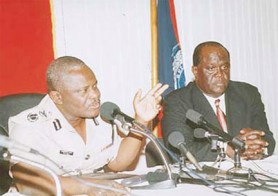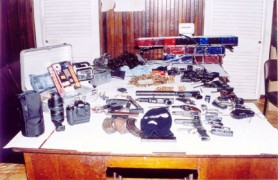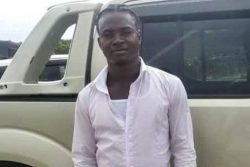
Persaud’s investigation
Despite Khan’s decade-long criminal career, the Police initiative has conveniently come only after the narco-trafficker had been removed from the jurisdiction, sentenced in a US court to imprisonment for drug-trafficking, witness-tampering and gun-running and is unlikely to be brought before a local court or commission of inquiry. Assistant Commissioner Seelall Persaud – who is leading the investigation – had stated in November 2007 that since Khan’s arrest in Suriname and rendition to the USA in 2006, execution-style killings in Guyana had dropped considerably from 43 in 2006 to 12 in 2007. The implication of Persaud’s pronouncement for Khan’s involvement is obvious.
Persaud said at that time, that Khan had a group of men who worked with him while he was here but, since he had been locked up, the men had all gone in different directions. “We believe that Mr Khan was involved in narcotics trafficking and since his arrest we have seen a fragmentation of his gang.
Instead of them being one place they are all over the place,” Persaud announced boldly. That was two years ago. This year, it was he who said lamely that the Force could have launched an investigation into Khan’s activities only if it was presented with information and evidence.

The belated announcement of a police investigation has come more than three years after the Force first issued a wanted bulletin for the arrest of Khan and three of his associates – Gerald Perreira, Paul Rodrigues and Ricardo Rodrigues – during Winston Felix’s tenure as commissioner. It has come also three days after Khan was sentenced in a Brooklyn Federal Court to fifteen years in prison for drug-trafficking, witness-tampering and gun running. Now that Khan cannot possibly be arrested here, the police Criminal Investigation Department has awakened suddenly to its responsibility for public safety. What was it meant to achieve?
The police announcement was made only after the Joint Opposition Parties – Alliance for Change; Guyana Action Party; National Front Alliance; People’s National Congress and Working People’s Alliance – had initiated the compilation of a ‘Dossier’ on state-sponsored violence and other crimes. They had also issued calls for an investigation to be conducted into Khan’s homicidal activities in Guyana.
In an attempt to establish a prima facie case and to mobilise support for an international inquiry into human violations, the opposition political parties on 17th November released their ‘Dossier.’ It chronicled unlawful killings over a decade and a half – coinciding mostly with the People’s Progressive Party’s tenure of office, but mainly dealing largely with the Troubles from 2002 to 2008.

The Dossier documented other abuses, including the torture and murder of citizens, some of which might have been carried out with state support. It examined the alleged link between the administration and organised crime, particularly the convicted narco-trafficker Khan, concluding that hundreds of killings which occurred during the Troubles which erupted in the wake of the 2002 Mashramani jailbreak were the result of gang warfare – between the ‘escapee’ gangs and Khan’s ‘phantom’ gangs.
Neither the CID investigation nor the JPOP dossier, however, can deal comprehensively with the transnational criminal network of which Khan’s organisation was a part. Neither is likely to determine exactly how many persons were killed during the Troubles and by whom. That would require the resources of the state or an international agency to establish an independent commission of inquiry that will be empowered to command the attendance of key witnesses.
An independent inquiry can learn much from former government ministers and officials, former commissioners and senior police officers, politicians, businessmen, criminals, victims and villagers who were involved in the Troubles. Neither the CID nor the JPOP has the authority to summon these witnesses to testify.
President Bharrat Jagdeo, however, has already taken the trouble to dismiss demands for such an independent commission of inquiry. He seems satisfied with the Police Force’s thin investigation of any crimes that Khan might have committed.
Khan’s murders
Khan’s reputation of involvement in murder seems to be known to everyone except the Guyana Police. In an affidavit submitted to the Federal court in Brooklyn to support the charges against Khan earlier this year, the United States Drug Enforcement Administration had asserted that “Khan was ultimately able to control the cocaine industry in Guyana, in large part, because he was backed by a paramilitary squad that would murder, threaten, and intimidate others at Khan’s directive. Khan’s enforcers committed violent acts and murders on Khan’s orders that were directly in furtherance of Khan’s drug trafficking conspiracy.”
Khan’s criminal intent was evident in several incidents in which he and his cohorts were involved. Large caches of weapons – far beyond reasonable need for personal protection – were found by the security forces close to Khan’s men. Although on some occasions they were arrested, they were invariably tried summarily in the magistrates’ courts and somehow always managed to escape conviction.
In one case, a Guyana Defence Force patrol at Good Hope, East Coast Demerara, intercepted and searched a vehicle which contained an arsenal of weapons on Wednesday 4th December 2002. Khan was accompanied by Haroon Yahya and Sean Belfield, then a serving member of the Police Force. The cache included M-16 assault rifles with night vision devices; Uzi sub-machine gun with silencer; Glock 9mm pistols; 12-gauge shotgun; other small calibre weapons; bullet-proof vests; helmets; a computer and other electronic gadgetry with digitised electronic maps and plans of Georgetown and certain targetted East Coast villages.
In a display of his reach, Khan contacted a serving officer of the Guyana Defence Force to obtain his release but he was overruled. A magistrate’s court eventually dismissed the charges against him.
In another case, Khan’s accomplices – including former policeman Paul Rodrigues and civilians Dennis Osbourne and Raul Gulliver – were arrested on 1st September 2004 when the police raided the Bel Air premises of Master Touch Carpet Cleaning and Construction Company, a business enterprise with which Khan was associated. The police seized ammunition, guns, millions of dollars in local currency, a pair of female police uniforms and wig, a flashlight, a computer and communication equipment and a gun-cleaning kit. Again, a magistrate’s court eventually dismissed the charges against them.
Even during his trial, Khan seemed to remain active in his trade. He was implicated in plans for murder when he and his former lawyers Robert Simels and Arianne Irving were charged with conspiracy to tamper with witnesses relating to the drug trial. Simels was accused of making an alleged US$1,000 payout and having discussions about “eliminating and neutralizing” witnesses.
He and his assistant allegedly had numerous discussions with a person – later identified as a US government informant – to locate certain individuals close to the case and to get them to rescind statements, not testify against Khan, or even to be “eliminated.”
Vaughn’s testimony
Selwyn Vaughn – a self-confessed former member of Khan’s ‘Phantom’ gang and a Drug Enforcement Agency informant – gave evidence to a New York court on 28th July that Khan ordered the execution of political activist Ronald Waddell. Vaughn told the court that Waddell – a former talk show host – had not only criticized Khan but was said to have links with the ‘escapee’ gang based in Buxton Village who were targets of Khan’s nightly hunting expeditions.
Vaughn, who is in custody and is cooperating with the law enforcement agencies, remains under special immunity that protects him from later prosecution in the United States. He spent an entire day on the witness stand where he disclosed that Khan, in addition to ordering Waddell’s execution, also ordered the execution of boxing coach Donald Allison in Agricola Village. It happened that Allison was the uncle of former military officer David Clarke who is in custody in the USA and was identified to testify against Khan. Khan was also alleged to have ordered the murder of Devendra Persaud, a narco-trafficker who had become a DEA informant and turned against his organisation.
Vaughn testified that weapons were brought illegally into Guyana from Brazil by an employee of a timber company that Khan later purchased. He told the court that, at one stage, Khan said just to run the ‘Phantom’ gang and, in order to pay all of his gangsters, he would have to land 500 kg of cocaine per year into the US and Europe!
Downfall
Khan’s downfall came as a consequence of several circumstances. First was his exposure in the December 2002 Good Hope and September 2004 Bel Air arms cache discoveries which linked him to ‘Phantom’ gang activity and large amounts of illegal weapons and equipment. Second was the report of the Federal Bureau of Investigation team which came to assist in the inquiry into the theft of 33 AK-47 assault rifles from the Guyana Defence Force in February 2006 which Khan masterminded and his accessories executed..
This was followed by the publication of the US Department of State’s International Narcotics Control Strategy Report for 2005 which was released in March 2006. The report for the first time named Khan as “a known drug-trafficker” sending a signal to the security forces to go after Khan while, in a rare coincidence, both the President and the Head of the Presidential Secretariat were out of the country at the same time. Information for the subsequent enforcement operations on 17th-20th March against Khan’s associates and properties was provided by the US Federal Bureau of Investigation. Khan was knocked off balance and was constantly on the run to avoid arrest.
Next came Khan’s cocky publication of whole-page ‘Statement’ in the newspapers on 12th May 2006 and the release to the media of the tape recordings of conversations of the Commissioner of Police gotten from wiretapping. The weapons theft and telephone tapping stunts, though cleverly executed with the complicity of venal insiders, incensed the Defence and Police Forces and intensified their operations against Khan who then fled to Suriname. There he was arrested on 15th June 2006. Suriname’s Minister of Justice Chandrikaperad Santokhi deemed Khan a threat to national security and linked him to more murder plots – the assassination of key government and judicial officials – in that country.
By 29th June 2006, Khan was expelled from Suriname and, on 30th June was arraigned before court on a charge of “conspiring to import cocaine” in the USA, bringing this phase of his criminal career to an end.
Jailed for fifteen years, Khan leaves many unanswered questions about what happened in the killing fields of Guyana. It still remains difficult to prove beyond doubt precisely how many persons were killed on Khan’s orders. It is for this reason that the administration has an obligation to the nation to establish an independent commission of inquiry to find out how a crook such as Shaheed ‘Roger’ Khan could have wrought so much havoc for so long.





